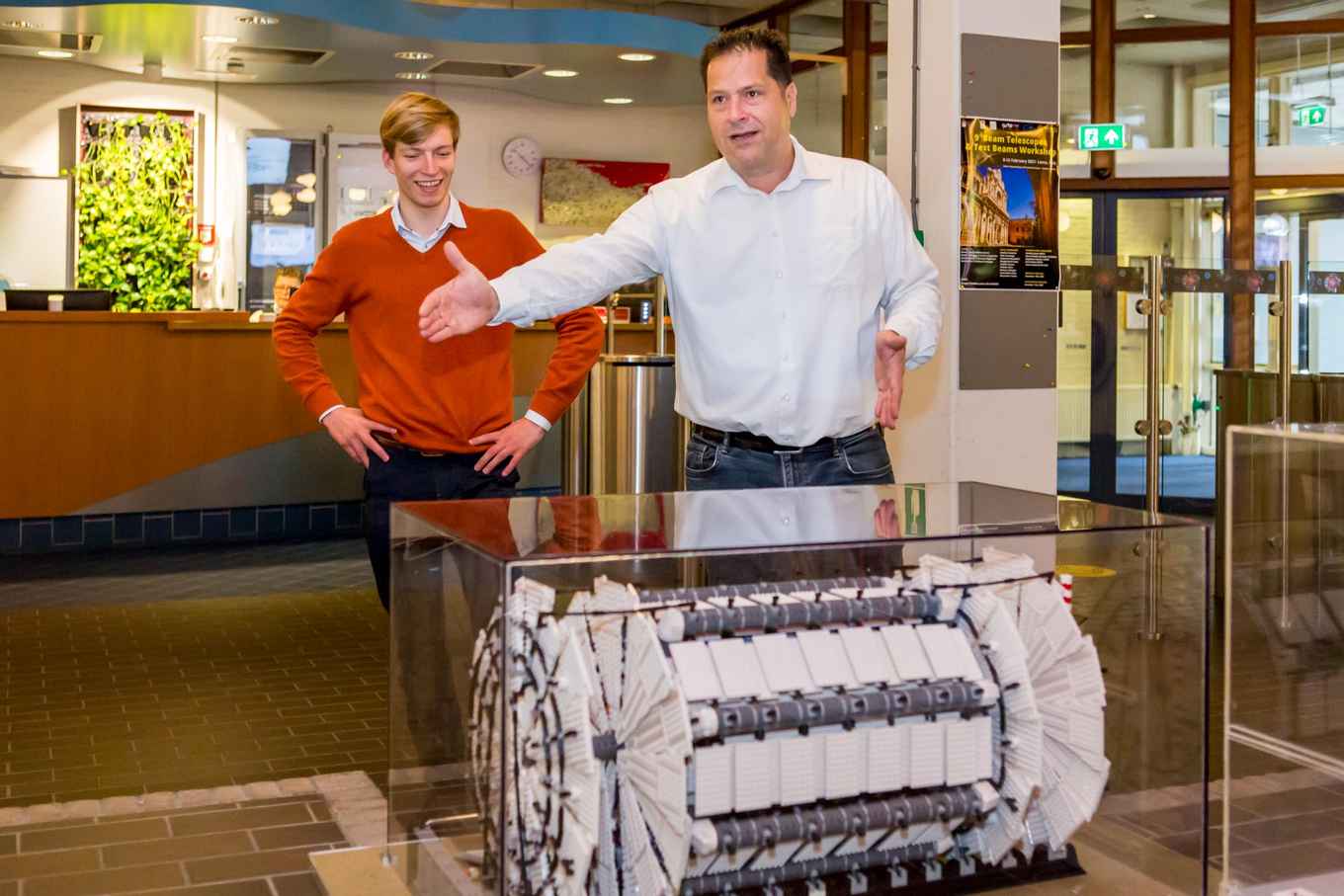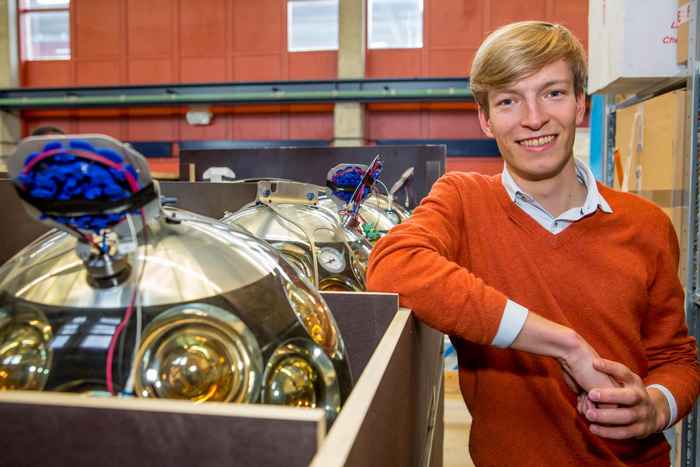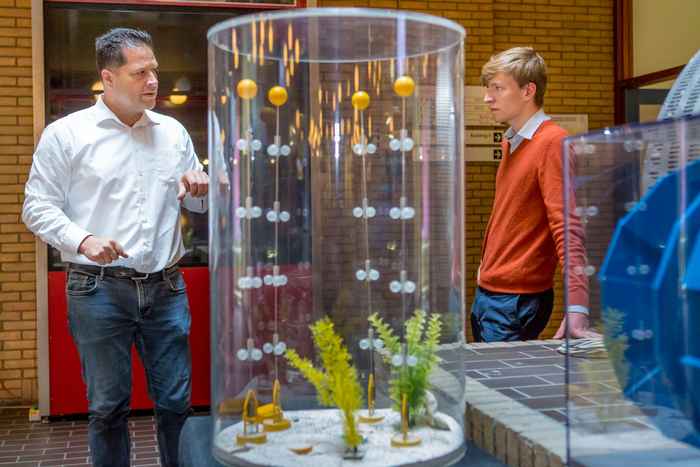20 years Faculty of Science: the past, present and future of Physics and Astronomy
22 September 2020

Tekst: Edda Heinsman. Fotografie: Liesbeth Dingemans
It's certainly a contrast with Nikhef, where the reception hall is packed with demonstrations. Vreeswijk clearly feels right at home, and runs into plenty of familiar faces who he greets with an elbow bump. Although everyone is sticking to the RIVM's Covid guidelines, congratulations are definitely in order: the researcher has just been informed he will be named professor.
Student Maurits Janssen is far less familiar with the Nikhef. Although he has done some research here and spent quite a bit of time walking around the building, he never really stopped to examine the demonstration models in the reception hall. Vreeswijk takes us on a little tour, leading past scale models of detectors. These machines are so large that it is difficult to imagine their actual size. The devices used to make particles visible are even more exciting. The tour leads past bubble chambers, in which passing particles leave condensation tracks. ‘Just like airplanes in the sky’, Vreeswijk explains. A rather high number of radioactive particles appear just as we are watching. Vreeswijk reassures us that this is normal background radiation. In any case, particles are clearly flying around all over the place. This is all the more evident in the next device, the spark chamber, where we can observe flashing muon traces.

Ski rack
Vreeswijk offers an in-depth explanation of each demonstration model, and we dive right in. A world of vast energies and tiny particles created elsewhere in the universe, perhaps during the collision and fusion of black holes. These particles have been travelling for millions of years and can now be measured in this demonstration model, which vaguely resembles a ski rack. Such grandiose terms might initially evoke images of high-end scientific research, but Vreeswijk explains what the project is all about: ‘Hisparc, a project for secondary school pupils. It gives them a taste of the sort of research we do here at Nikhef.’
Student Maurits Janssen wasn't drawn to study physics by a similar student project. He came to the UvA for the city, and the great atmosphere. ‘It was also one of the few universities that actually admitted me.’ As Janssen explains, his academic career has hardly been standard. After finishing senior general secondary education, he completed his propaedeutic year in technical physics, and was subsequently admitted to the UvA's physics Bachelor's. It certainly seems to have been the right decision. He has since completed his Bachelor's programme (with the exception of one practical subject, due to Corona). He also hasn't had enough of physics yet. ‘I always thought I wanted to end up in the corporate world. But I must say I'm getting more enthusiastic about pursuing science now that I've finished my Bachelor's project and attended the first Master's lectures.’
An expensive game of Operation
Among other projects, he might well end up working on the ITk detector, the ATLAS detector upgrade currently in its early stages of development. We walk into a large hall and Vreeswijk, who works at ITk as a project engineer, slides open a screen. Behind it lies a carbon fibre ring, the prototype of the new ATLAS detector's interior. Janssen carefully lifts out one of the panels. ‘This is just a model, the actual panels filled with equipment will cost a hundred thousand euros each. They'll have to be inserted into the detector with great care. If they bang into something, they'll break. It's an almost superhuman effort’, Vreeswijk explains. It might end up being a very expensive game of Operation. That's why a robot is currently being built in Germany in order to carefully slide in the 64 panels.
We continue our tour of the building, past the instrument shop, engine rooms and clean room. We arrive at a small room with a sign saying ‘gravitational waves’ and arrows pointing inside. An enormous grey device looms inside. This is where the first tests are being carried out for a yet to be built gravitational wave detector. South Limburg would offer an ideal location for the new facility. ‘Although we already knew that gravitational waves had to exist a hundred years ago, we haven't been able to detect them until recently,’ Vreeswijk explains. ‘It will be a whole new eye to explore the universe through.’ Janssen responds enthusiastically: ‘Awesome! I worked on gravitational waves for a few months as a part of my practical training, so it's really cool to see this device now.’
They enter another room storing crates of globes crammed with equipment. These are detection eyes for KM3net, the giant detector currently being built in the Mediterranean Sea. Janssen also worked on this project as part of a module. ‘The detector is designed to detect neutrinos,’ Janssen explains. ‘However, it can't observe the actual neutrinos. They pass through everything, even the earth. Only very rarely does a neutrino collide with a nucleus, causing muons to be released. When this happens in the sea, it generates a minute amount of light which can then be measured with these spheres.’

Den of thieves
So have all these projects been delayed due to the Corona crisis? ‘We've been closed for three months, so everything's been held up at least that long,’ Vreeswijk explains. Quite a few people are now back to work in the building, and it's mainly the technicians who can't work from home. So what about Janssen? ‘This is my first day back at the UvA. I actually don't have any offline lectures at the moment,’ he adds. ‘That's a real shame. I miss interacting with the lecturer and other students. The campus offers lots of benefits like good study places and sports facilities. As a result, you don't go home straight after lectures. For example, you might want to work out or play sports together first. It's also a good way of making new friends.’ Although Vreeswijk isn't one for nostalgia, he does miss one aspect of his student days in the former diamond-cutting factory: ‘The current study places and facilities are obviously wonderful, but physics really had its own spot in those days, a bit of a den of thieves. Those days are gone now.’
Specialising
The Faculty of Science has been around for twenty years now, what can we expect from the next twenty? ‘I expect the programme will become even more focused on students' academic skills. We will be moving towards a broader Bachelor's with more specialisation in the Master's phase,’ Vreeswijk suggests.
So what about science? ‘There is still so much to be discovered,’ Vreeswijk enthuses. ‘Dark matter, that's the real holy grail: what is it? What is this dark energy? How can we explain the differences between matter and antimatter? Are we really living in 3 or even 4 dimensions? I believe it's all linked to quantum gravity. I expect we'll gain a lot more insight in that area through our current experiments. One example would be ATLAS, where we've only seen 5% of the data we'll ultimately collect. You could compare it to a picture which is only 5% visible, and has been all jumbled up. You basically have no idea what you're looking at. There's so much to be discovered, it's hard to even imagine.’
Lees ook
- 20 years Faculty of Science: the past, present and future of Biology
- 20 years Faculty of Science: the past, present and future of Biomedical Sciences
- 20 years Faculty of Science: the past, present and future of Psychobiology
- 20 years Faculty of Science: the past, present and future of Information Studies
- 20 years Faculty of Science: the past, present and future of Artificial Intelligence
- 20 years Faculty of Science: the past, present and future of Chemistry
Twitter and stay informed of scientific insights and the latest news about the Faculty of Science.
